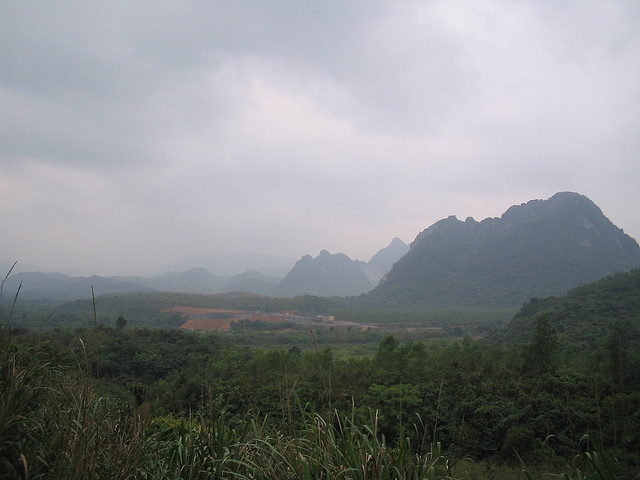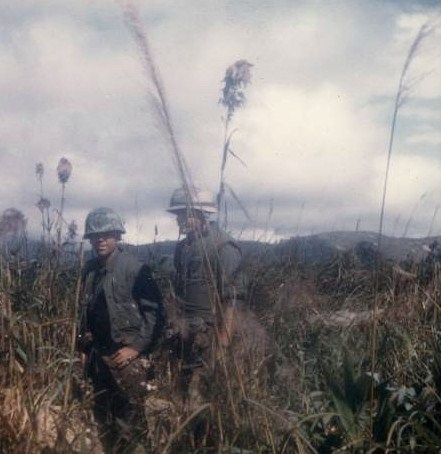 This is a war story. It does have a little math, physics, and technology in it, but the real reason I’m writing about it is that Harry Baig got under my skin. Baig was a Marine, and in 1968, during the Vietnam War, he was among those trapped in a siege at Khe Sanh. Baig’s first name wasn’t actually “Harry,” it was Mirza Munir; he was Muslim, a Pakistani aristocrat who wore jodhpurs and carried a large curved sword and because he’d been educated in England while his father was an ambassador in Washington, DC, he had an English accent. Everyone said he was brilliant, he was a factor in getting the Marines out of Khe Sanh, and he died young and badly.
This is a war story. It does have a little math, physics, and technology in it, but the real reason I’m writing about it is that Harry Baig got under my skin. Baig was a Marine, and in 1968, during the Vietnam War, he was among those trapped in a siege at Khe Sanh. Baig’s first name wasn’t actually “Harry,” it was Mirza Munir; he was Muslim, a Pakistani aristocrat who wore jodhpurs and carried a large curved sword and because he’d been educated in England while his father was an ambassador in Washington, DC, he had an English accent. Everyone said he was brilliant, he was a factor in getting the Marines out of Khe Sanh, and he died young and badly.
I was researching for a book when I came across a chaplain named Ray Stubbe, who had also been in the siege at Khe Sanh, who didn’t know Baig — why not? — and likewise found him interesting. So years later, Stubbe interviewed Baig’s family and researched military history, declassified documents, soldiers’ memoirs, and CIA debriefings, and wrote an essay about Baig that was detailed but vague on the logic in exactly the way you’d expect if Baig was in Marine counter-intelligence, which he was.
Baig was 25 when he joined the Marines in 1957 and by 1964 was in Vietnam on intelligence operations, which had been going on quietly since 1960 and which included getting to know the locals, interrogating enemy prisoners, and figuring out where the enemy, the North Vietnamese troops, were. Then for some reason — because he’d been in battles and knew North Vietnamese tactics? — in the summer of 1966, he was in Santa Barbara, California, briefing a secret group of academic physicists, probably on North Vietnamese infiltration habits. Then he went back to Vietnam, establishing “collection nets” that would help predict where the enemy would be next.
 In January, 1968, Baig reported to Khe Sanh, a Marine base surrounded by high hills on three sides, just in time for the North Vietnamese to move into those encircling hills and cut off the road out on the fourth side. The only way into and out of Khe Sanh was by air and under fire. The ratio of Marines to enemy was around 1:4, and the enemy was mostly invisible during the day, attacking at night, digging tunnels and trenches, drawing the siege lines tighter and tighter. The last time this happened was in 1954 with a French military base and the same North Vietnamese general; the French lost.
In January, 1968, Baig reported to Khe Sanh, a Marine base surrounded by high hills on three sides, just in time for the North Vietnamese to move into those encircling hills and cut off the road out on the fourth side. The only way into and out of Khe Sanh was by air and under fire. The ratio of Marines to enemy was around 1:4, and the enemy was mostly invisible during the day, attacking at night, digging tunnels and trenches, drawing the siege lines tighter and tighter. The last time this happened was in 1954 with a French military base and the same North Vietnamese general; the French lost.
But this time that secret group of academics had designed the first electronic battlefield – seismic and acoustic sensors dropped in enemy territory which signaled the enemy’s location — and handed it over to the military, who used it for the first time at Khe Sanh. Because he’d briefed the group, Baig must have known roughly how to use the sensors, though apparently few others did.
By now his title was Target Intelligence Officer; the area around Khe Sanh held 3,000 separate targets; Baig’s colleague said he had a head like a computer. He’d collect the sensors’ signals, analyze them for the enemy’s location, analyze subsequent signals for the enemy’s movements, put it all together with his intelligence training and his knowledge of the enemy’s military habits, then draw imaginary boxes around the targets into which bombers and artillery would pour “walls of steel.” Once an enemy artillery round hit the camp, leaving a small crater. Baig measured the crater, looked around until he found a piece of hot shrapnel, bounced it in his hand, looked at it carefully, examined a map, and calculated the coordinates of the enemy artillery — which of course the Marines knocked out.
Eventually, after 70 days of this, the North Vietnamese got tired of not winning, and in fact, of losing ammunition dumps, truck parks, camps, and weapons positions, and of having their attacks shot up before they could even start them; so they went and attacked elsewhere. The Marines got out of Khe Sanh. Stubbe thought Baig was a major reason they made it out alive. Baig was awarded a Legion of Merit.
The Marines thought he was funny, tremendously intelligent, and “bubbling with enthusiasm.” He’d open his C-rations and exclaim, “Aha! I have cookies!” He’d run around the camp, telling jokes about eating pork and killing infidels, yelling about incompetence, wearing a Boy Scout pack he’d gotten from Sears Roebuck where his uncle worked. In the two photos of him I’ve seen, he’s thin and short, dark hair in a widow’s peak, wearing dark-rimmed glasses too large for his face. He has a little smile, intense eyes, and he does indeed look funny and smart.
After Khe Sanh and a short leave back to the United States, Baig was assigned to Thailand from which he would make undercover forays into Laos – native dress, make-up, French accent and all – and find things out and then return to Bangkok. His wife and daughter lived with him there in the Imperial Hotel. On April 20, 1971, a grease fire broke out in the hotel kitchen, spread through the ventilation system, and killed Baig, his 30-year old wife, and his 10-year old daughter. Baig was 39. The fire escape doors on their corridor had been bolted shut from the outside and Stubbe says flat out that Baig was assassinated — wouldn’t a hotel fire be an unreliable method of assassination?
In November, 1971, seven months after Baig died, his commander read aloud his report on Khe Sanh at a congressional hearing that established the value of this new way of fighting, this electronic battlefield. Since 1971 and with manifold improvements, the electronic battlefield is at this minute using sensors to analyze enemies’ actions, figure out enemy locations, and bomb the hell out of them.
And now you’d like to know why I’m interested in this story. Baig was such an unlikely person — a well-connected Pakistani Muslim in Marine counter-intelligence. Maybe I’m just naive and most people in counter-intelligence are unlikely. Or maybe his real unlikeliness was in the combination of the attitude of bubbliness, the raw intellect that could hold a piece of shrapnel and calculate its trajectory back to its source, and the ability to calmly, repeatedly order lethal walls of fire. I’m always interested when people have to make decisions that balance the pragmatic and the moral. But I don’t know enough about Harry Baig to know if he was weighing the need to get out of Khe Sanh against thou-shalt-not-kill; or if he was just happily doing a little math, a little physics, and blowing the enemy infidel — and aren’t all enemies infidels? — to kingdom come.
__________
Photos: Khe Sanh – Routard05; Hill 881S, Khe Sanh – Marine Corp Archives and Special Collections
What an incredible story, Ann!
seriously. and totally unexpected.
i like the idea of weighing the pragmatic and moral, but he seems like the kind of person that would have this attitude in any profession he fell into, whether a teacher, a magnate, an artist, etc. just one of those people (who i cannot identify with) who are able to find productive joy in whatever they do, wherever they are. so in other words, i don’t know about the pragmatic/moral thing; rather, i think he was weighing LIFE vs life, and the latter always stayed light as a feather.
and i think this guy would have been a real gas to get a drink with.
Spence, I think you must be right about Baig, that he was just doing what came naturally, just having some kind of fun. And I love that, life staying light as a feather. Also a gas to get a drink with.
I’m more interested to know what the VC who were interrogated by him in their own land thought of him.
That too. Not that the VC were sweeties either.